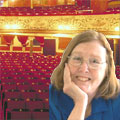- By Judith Pratt
- Entertainment
 Print
Print  Two years ago, at the Kitchen Theatre, Eric Gilde played an American soldier on his way to WWII, in Last Train to Nibroc. Now he is playing a Canadian soldier who leaves the prairies to join a cavalry regiment in the Great War.
Two years ago, at the Kitchen Theatre, Eric Gilde played an American soldier on his way to WWII, in Last Train to Nibroc. Now he is playing a Canadian soldier who leaves the prairies to join a cavalry regiment in the Great War. Mary's Wedding, by Stephen Massicotte, shifts back and forth in time as Charlie (Gilde) and Mary (Ellen Adair) meet, fall in love, and undergo the water-filled trenches and poison gas of the First World War. At first, the play's jumps in time and poetic dialogue are slightly off-putting, but ultimately they make this romance into something larger. The spare staging and interlocking images of Mary's Wedding show a war of the imagination, both more and less awful than the gritty realism of war movies.
A windswept sky and line of grass dominate David L. Arsenault's set, which, along with his lighting, perfectly suggests both the Canadian prairies where Mary and Charlie live and the darkly exploding trenches of the war. The barn where the lovers meet becomes the field of war: bags of feed become sandbags; crates become trench walls; and the loft becomes Charlie's beloved horses. Massicotte's poetry, and our imaginations, supply all the rest.
The story, Charlie explains, "begins at the end and ends at the beginning." So do the plays' images, looping back over each other as in good poetry. These winding images underscore how the story moves in and out of Mary and Charlie's dreams-or perhaps takes place only in their dreams.
Director Rachel Lampert has cast the actors well-Gilde as the strong son of the soil; Adair as the British-born girl who revels in the freedom of her new land. Adair also plays Charlie's sergeant, Gordon Muriel Flowers, creating a tough campaigner while, amazingly, wearing a white dress and bare feet. (The simple costumes, by Lisa Boquist, effectively take the characters through the years and events of the play.)
Mary is a strong, charming Mary, although sometimes a little over-exuberant-perhaps beguiled by Lampert's over-energetic blocking. Gilde, however, remains solidly planted even under fire. Both actors manage the shifts of time and place with complete conviction, and their changing emotional landscape even better.
Along with the windswept set, I first noticed the opening piano music, a lovely Edwardian piece that I couldn't quite recognize-because it, like the rest of the play's wonderful soundscape, was composed by Mer Pantaleoni Boel. Sound designer Leslie Green helps out with fine thunder and artillery effects. Lampert has done great service to Masicotte's script by choosing this design team.
Both play and production painfully evoke a long-ago war. During one of the war scenes, Mary says "I can do nothing about it. I cannot do anything about it." Mary's Wedding made me wish that we could.
v7i22



